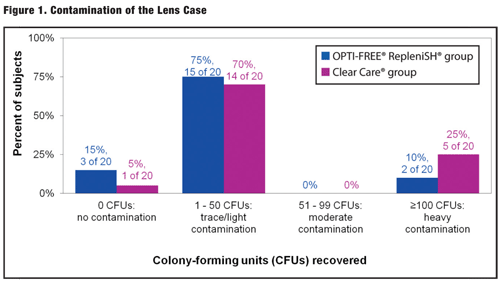Contact lens care compliance may be a risk factor when it comes to eye infections such as microbial keratitis. The type of pathogen cultured from the infected eye may correlate to the same pathogen in the contact lens case; case contamination rates can vary from 34% to as high as 82%.1-3 In one study, poor case hygiene increased the risk of microbial keratitis 3.7 fold.4
When a patient walks into my office with a potential contact lens-related microbial keratitis, I first examine internal office procedures to make sure our message with contact lens wearers is being conveyed properly. Then I ask the patient the following questions:
• Do you sleep in your lenses?
• Do you use fresh solution or top off?
• Do you wash and dry your hands every time before handling your lenses?
It is imperative you ask your patients several compliance questions at every scheduled and emergency visit to understand their contact lens care routine.
In the spring of 2010, I completed a clinical trial, funded by Alcon Research, Ltd., entitled, “Compliance and Contamination in Contact Lens Wear.” A subsequent poster was presented at the American Academy of Optometry meeting in San Francisco in November 2010. In this trial, patients were surveyed regarding their current lens care habits. If a patient was using either OPTI-FREE RepleniSH® MPDS or Clear Care® Disinfection Solution, they were offered to participate in a study that examined lens care hygiene, lens contamination rates and case contamination rates after two weeks of habitual lens care. After completing the informed consent process, subjects were enrolled, given new contact lenses, a new case and a new bottle of solution for the two-week study period. They were asked not to change their lens care habits based on their entrance survey. The results for both groups demonstrated non-compliant habits. No lenses in either group were heavily contaminated. Cultured case contamination results demonstrated no statistical difference between OPTI-FREE RepleniSH® MPDS or Clear Care® Disinfection Solution, however Clear Care® had a higher trend for contamination in the heavy colony-forming unit group (see figure 1).5
The results of this study clearly show that OPTI-FREE RepleniSH® is just as effective as Clear Care® in regards to lens/case contamination rates in real world environmental testing. When selecting or prescribing a solution for your patients, consider all factors including cleaning, wettability and disinfection.

1. Ogushi Y, Eguchi H, Kuwahara T, et al. Molecular genetic investigations of contaminated contact lens storage cases as reservoirs of Pseudomonas aeruginosa keratitis. Jpn J Ophthalmol. 2010 Nov;54(6):550-4.
2. Yung MS, Boost M, Cho P, Yap M. Microbial contamination of contact lenses and lens care accessories of soft contact lens wearers (university students) in Hong Kong. Ophthalmic Physiol Opt. 2007 Jan;27(1):11-21.
3. Gray TB, Cursons RT, Sherwan JF, Rose PR. Acanthamoeba, bacterial, and fungal contamination of contact lens storage cases. Br J Ophthalmol.1995 Jun;79(6):601-5.
4. Willcox M, Carnt N, Diec J, et al. Contact lens Case contamination during daily wear of silicone hydrogels. Optom Vis Sci. 2010 Jul;87(7):456-64.
5. Mayers M. Compliance and Contamination in Contact Lens Wear. Poster presented at AAO meeting, November 17-20, 2010. San Francisco.


